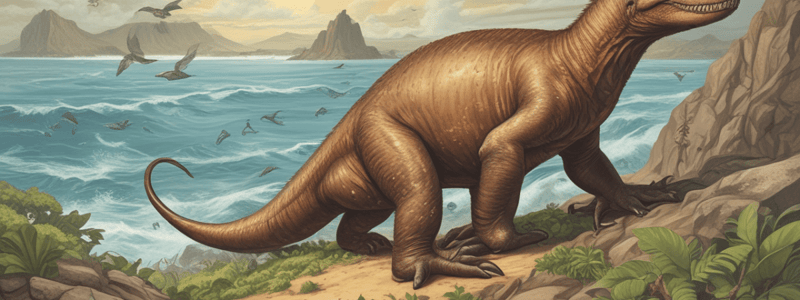Podcast
Questions and Answers
What was a pivotal moment in Darwin's understanding of evolution during the Beagle voyage?
What was a pivotal moment in Darwin's understanding of evolution during the Beagle voyage?
- Collection of plants and animals in Tahiti
- Observations of species in the Galapagos Islands (correct)
- Discovery of fossils in South America
- Navigation challenges in the Cape of Good Hope
What did Darwin recognize as important in shaping the Earth's surface?
What did Darwin recognize as important in shaping the Earth's surface?
- Glacial movement
- Uplift and subsidence (correct)
- Weathering and erosion
- Plate tectonics
What was the purpose of Darwin's species collection during the Beagle voyage?
What was the purpose of Darwin's species collection during the Beagle voyage?
- To observe the migratory patterns of birds
- To study the behavior of animals in their natural habitats
- To analyze the ecological balance of different ecosystems
- To collect and classify new species for further study (correct)
What did Darwin realize about the fossils of extinct species he discovered?
What did Darwin realize about the fossils of extinct species he discovered?
What method did Captain Robert FitzRoy use to determine the HMS Beagle's position during the voyage?
What method did Captain Robert FitzRoy use to determine the HMS Beagle's position during the voyage?
Where did the HMS Beagle set sail from in 1831?
Where did the HMS Beagle set sail from in 1831?
Flashcards are hidden until you start studying
Study Notes
Darwin's Beagle Voyage
Galapagos Islands
- Visited in 1835, a pivotal moment in Darwin's understanding of evolution
- Observed distinct species of tortoises, mockingbirds, and finches that varied between islands
- Realized that species on different islands were similar but not identical, sparking thoughts on adaptation and speciation
Geological Observations
- Darwin collected numerous geological specimens and made observations on volcanic and coral reef formations
- Recognized the importance of uplift and subsidence in shaping the Earth's surface
- Noted the similarity between South American and Galapagos geological formations, supporting the idea of continental drift
Species Collection
- Collected over 450 species of plants and animals, including many new species
- Preserved specimens using various methods, including skinning, stuffing, and pickling
- Sent many specimens back to England for further study and classification
Fossil Discoveries
- Discovered fossils of extinct species, including giant armadillos and ground sloths
- Realized that these fossils were related to modern species, but were more primitive
- Recognized the significance of fossil record in understanding Earth's history and evolutionary processes
Voyage Route And Navigation
- HMS Beagle set sail from Plymouth, England in 1831
- Voyage route included South America, Galapagos Islands, Tahiti, New Zealand, and Cape of Good Hope
- Navigation was challenging, with Captain Robert FitzRoy using celestial observations and chronometers to determine the ship's position
Darwin's Beagle Voyage
Galapagos Islands
- Visited in 1835, marking a pivotal moment in Darwin's understanding of evolution
- Observed distinct species of tortoises, mockingbirds, and finches that varied between islands, sparking thoughts on adaptation and speciation
- Recognized that species on different islands were similar but not identical, leading to questions on how they evolved
Geological Observations
- Collected numerous geological specimens, including volcanic and coral reef formations
- Recognized the importance of uplift and subsidence in shaping the Earth's surface
- Noted the similarity between South American and Galapagos geological formations, supporting the idea of continental drift
Species Collection
- Collected over 450 species of plants and animals, including many new species
- Preserved specimens using various methods, including skinning, stuffing, and pickling
- Sent many specimens back to England for further study and classification
Fossil Discoveries
- Discovered fossils of extinct species, including giant armadillos and ground sloths
- Realized that these fossils were related to modern species, but were more primitive
- Recognized the significance of the fossil record in understanding Earth's history and evolutionary processes
Voyage Route And Navigation
- HMS Beagle set sail from Plymouth, England in 1831
- Voyage route included South America, Galapagos Islands, Tahiti, New Zealand, and Cape of Good Hope
- Navigation was challenging, with Captain Robert FitzRoy using celestial observations and chronometers to determine the ship's position
Studying That Suits You
Use AI to generate personalized quizzes and flashcards to suit your learning preferences.




